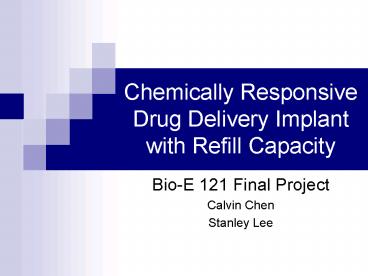Chemically Responsive Drug Delivery Implant with Refill Capacity PowerPoint PPT Presentation
1 / 18
Title: Chemically Responsive Drug Delivery Implant with Refill Capacity
1
Chemically Responsive Drug Delivery Implant with
Refill Capacity
- Bio-E 121 Final Project
- Calvin Chen
- Stanley Lee
2
Overview
- Background Information
- Current technology
- Improvements with miniaturization
- Design of New Chip
- Schematics
- Mechanisms
- Fabrication
- Applications Diabetes
- Conclusion
3
Background Information
- Current Technology for Drug Delivery
- Injections
- Pills
- Macroscopic drug delivery systems
- Biodegradable Injected Systems (nanoshells)
- Epidermal patches
- Inhalants
- Needleless injection
- (gas burst)
4
- Problems With Current Systems
- Inconsistent drug levels over time
- Big and bulky implantable systems
- Forget to take pills (birth control)
- Inconvenient visits to the doctor
- Infection or spotting from multiple injections
5
Improvements with Miniaturization
- Controlled drug flow
- Active system adapts to changing body conditions
- Faster delivery
- Reduced power consumption
- Less moving parts
- Site specific delivery reduces side effects
- Cheaper
6
Hydrogels
- Water swollen 3-D cross-linked network of
hydrophilic polymers - Environmentally sensitive polymer gels
- Different chemical composition determines
response to pH, temperature, electric field,
light, carbohydrates, antigens, or proteins - Polymer network exhibits volume change response
- Considered to be the most efficient polymer
system in transforming molecular energy into
mechanical force
7
Why use hydrogel?
- Advantages
- No power required
- No wear or friction by moving parts
- Adaptable to different stimuli
- Easily fabricated, without clean room
- Large force generation and displacement
8
Hydrogel Actuation (pH response)
- As pH varies, the networks become charged by
protonation of amine groups or deprotonation of
acid groups - Repulsion of like charges collapse hydrogen bonds
at high pH levels and cause network to expand and
fill with water, resulting in volume change and
vice versa
9
Hydrogel Valve Implementation
- pH sensitive hydrogel consists of 2-hydroxyethyl
methacrylate (HEMA) and acrylic acid in a 41
ratio, ethylene glycol dimethacrylate (EGDMA) and
Irgacure 651 before UV polymerization - pH insensitive hydrogel consists of HEMA, EGDMA
and Irgacure 651 before UV polymerization - Backward flow negligible
10
Hydrogel Characterization
11
The Refill Port
- The refill port of chip will be slightly raised
so it can be felt through the skin - Silicone rubber septum is biocompatible and
self-sealing - Implant is located in abdomen where there is
sufficient tissue for support to prevent movement
during refill - Need a way to determine when the chip needs to be
refilled - Stainless steel needle stop lines refill port to
prevent damage/puncture of chip during refill
12
Chip Design
13
- major axis 2 in.
- minor axis 1.5 in.
- Height 0.5 in.
Total reservoir volume 3-5 mL
14
Material Selection
- Biocompatibility concerns
- Device cannot corrode
- Cannot react with drug to produce toxic side
products - Long life
- Proposed Materials
- Polymers (PMMA, PDMS, Teflon, Polyethylene etc.)
- Titanium
- Glass
- Silicon
15
Fabrication
16
Example Application Type I Diabetes
- Kinetics of injection administered drug does not
mimic natural body insulin secretion response - Near the pH sensing area of the hydrogel, glucose
oxidase/catalase can be applied, which reacts
with glucose in the blood to alter the pH level
in that area. - High glucose concentration leads to lower pH
levels, low glucose concentration leads to higher
pH levels.
17
Drawbacks of System
- Need to test for leakage
- Although fatigue is minimal, its still present
in the hydrogels and reservoir - Somewhat imprecise dosages
- Because of small size, capacity is limited
- Need to test release rate/long period of time
(constant flow rate) - Hydrogel swelling can be slow
18
The Future of Drug Delivery
- Future improvements will allow chip to be applied
to more challenging disease treatments - Site specific delivery by catheter so
concentration of drug is high only where needed - Advanced diseases that will be treated
- chronic pain
- Parkinsons and Alzheimers disease
- Deliver treatment neurotransmitters past
blood-brain barrier - antibiotic delivery
- Insoluble drugs have to be mixed with chaotic
flow fields - hormone treatments

